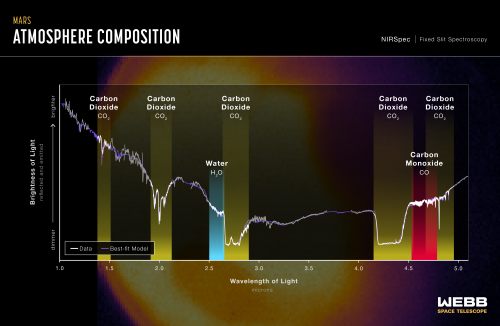The James Webb Space Telescope captured its first images and spectra of Mars on September 5, 2022. The telescope’s remarkable infrared sensitivity provides a unique perspective on our neighboring planet, complementing data collected by orbiters, rovers, and other telescopes.
Because it is so close, the Red Planet is one of the brightest objects in the night sky in terms of both visible light (which human eyes can see) and the infrared light that Webb is designed to detect. This poses special challenges to the facility, which was built to detect the extremely faint light of the most distant galaxies in the universe. Webb’s instruments are so sensitive that without special observing techniques, the bright infrared light from Mars is saturating the detector.
Webb’s first images of Mars, captured by the Near-Infrared Camera (NIRCam), show a region of the planet’s eastern hemisphere at two different infrared wavelengths.
The shorter wavelength (2.1 microns, Top right in figure 1) is dominated by reflected sunlight, and thus reveals surface details similar to those apparent in visible-light images. The rings of the Huygens Crater, the dark volcanic rock of Syrtis Major, and brightening in the Hellas Basin possibly caused by localized dust deposition are all visible in this image.
The longer wavelength (4.3 microns, Bottom right in figure 1) shows thermal emission – light given off by the planet as it loses heat. The brightness of 4.3-micron light is related to the temperature of the surface and the atmosphere. The subsolar point on the planet (the location on the surface where the Sun is directly overhead) is brightest because it is generally warmest. The brightness decreases toward the polar regions, which receive less sunlight, and less light is emitted from the cooler northern hemisphere, which is experiencing winter at this time of year.
However, temperature is not the only factor affecting the amount of 4.3-micron light reaching the telescope with this filter. As light emitted by the planet passes through Mars’ atmosphere, some gets absorbed by carbon dioxide molecules. The Hellas Basin – which is the largest well- preserved impact structure on Mars, spanning more than 2000 kilometers – appears darker than the surroundings because of this effect.
“This is actually not a thermal effect at Hellas,” explained Geronimo Villanueva of NASA’s Goddard Space Flight Center, who designed these Webb observations. “The Hellas Basin is a topographical low, and thus experiences higher air pressure. That higher pressure dampens the strength of the thermal emission at this particular wavelength range due to an effect called pressure broadening.”
Villanueva and his team, which includes members of the Planetary Atmospheres group of IASB-BIRA, also released Webb’s first near-infrared spectrum of Mars, demonstrating Webb’s power to study the Red Planet with spectroscopy.
Astronomers analyze the detailed shape of the spectrum to gather additional information about the surface and atmosphere of the planet. This infrared spectrum was obtained by combining measurements from all six of the high-resolution spectroscopy modes of the Webb’s Near-Infrared Spectrograph (NIRSpec). The spectrum shows a rich set of spectral features that reveal information about dust, icy clouds, rocks on the planet’s surface, and molecules that make up the atmosphere. The spectral signatures of water, carbon dioxide, and carbon monoxide are easily detected.
In the future, the Mars team will be using these imaging and spectroscopic data to explore regional differences across the planet, and to search for trace species in the atmosphere, including methane and hydrogen chloride.
These NIRCam and NIRSpec observations of Mars were conducted as part of Webb’s Cycle 1 Guaranteed Time Observation (GTO) Solar System program led by Heidi Hammel of AURA.



